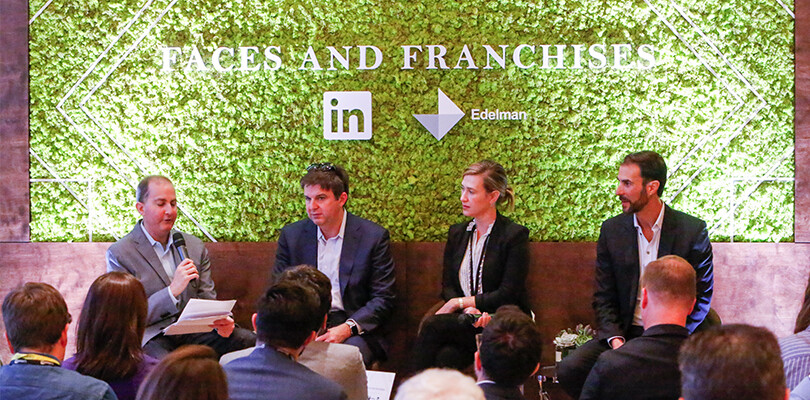The Power of Content Franchises and Other Lessons Marketers Can Learn from the Entertainment Industry
The entertainment industry, as demonstrated by the rise of Pandora and Spotify in music and the proliferation of brilliant television (think everything from “The Sopranos” to “Mad Men”), has been on disruption’s front lines.
Despite this disruption, Disney produced four separate billion dollar content franchises for the first time in 2016. That financial success is just one reason why Steve Rubel, Chief Content Strategist at Edelman, believes that the marketing sector can learn a lot from how the entertainment industry has handled its disruption.
We agree, which is why we partnered with Edelman at last week’s Consumer Electronics Show in Las Vegas to host a panel, “Faces and Franchises: The Power of Content Franchises.” Our panelists offered hard-earned advice on how marketers can harness the emotional storytelling, content franchises, and blockbuster distribution to reach their audiences in this age of disruption.
- Rich Greenfield, Media and Technology Analyst, BTIG
- Amy Powell, President, Paramount Television and Digital Entertainment
- Ben Silverman, co-CEO and Chairman, Propagate
The War for Your Attention
The Internet has ushered in a proliferation of channels and an explosion of competition. In this digital world, marketers are competing with everything and everyone from cable television to YouTube to Kim Kardashian for your attention.
Greenfield described the situation this way: “You watch so much content. Everyone wants your time. It’s a war for time.”
Due to time shifting, cord cutting, and other technologically-driven trends, Greenfield foresees a shift away from television advertising. Where will marketers invest the approximately $70 billion they’re now spending on interruptive 30-second TV spots?
Many marketers will turn their attention to creating content their audience will actually seek out. Greenfield pointed out that the average YouTube video on the site’s leaderboard is about two-and-a-half minutes. The bottom line is that if it’s great content, even if it contains a marketing message, people will watch it.
Of course, that is easier said than done. Finding the people to create great content (who aren’t already writing for, say, “Game of Thrones,”) is difficult.
“There’s a reason why talent is called talent,” Powell said.
“Most live video is boring,” Greenfield said, noting that most marketers, because it hasn’t been a needed skill until recently, simply don’t know how to shoot good video. (“It’s always good to use a light,” Silverman joked).
But some B2B marketers have cracked the code. Greenfield offered Volvo Trucks’ Jean-Claude Van Damme videos as a prime example. “That to me was a consumer marketing campaign from a B2B brand,” he said.
In New and Old Content Franchises We Trust
In the entertainment industry, content franchises — think “Star Wars” and the Marvel movies — are coveted properties. Because of their brand value, these properties can function like annuities for their owners.
At Paramount, Powell said that the company’s century-old library of content is a powerful asset. One of the uses of this catalog is repurposing. Powell cited the example of reworking the musical “Grease,” which Paramount had previously produced as a movie, for a live performance on television. She also noted that Paramount is using producing a TV series starring John Krasinski as Jack Ryan, based on the character created by Tom Clancy.
How can marketers leverage content franchises? Powell noted that Dollar Shave Club has built a franchise around its humor-driven videos and other content. Rubel pointed out that his company has produced its own franchise, the Edelman Trust Barometer, since 2001. At LinkedIn Marketing Solutions we’ve built a content franchise around our “Sophisticated Marketer’s Guides.”
Creating content, let alone a content franchise, can be a daunting project. But Silverman suggested that marketers can work with experienced content creators to boost their content quality. He offered many examples of his brands, from American Express to LensCrafters to Wal-Mart, partnering with Hollywood production companies to create content franchises.
Embracing the Disruption and Data of Platforms
These new digital platforms possess a key advantage: They have rich data on their users. “Netflix knows who you are, but ESPN doesn’t,” Greenfield said, adding: “The media industry operates with no data except Nielsen data.”
Silverman said he carefully considers the platform when pitching a project. For instance, he noted that he only pitched “The Tudors” to Showtime, because he believed the program was the right mix of highbrow and R-rating for the platform.
The lesson for marketers, Silverman said, is that they also need to consider the platform before deciding to share their content. A key question: does the platform reach a marketer’s audience. “If the platform is not at scale, it’s hard to justify the investment to make the content,” Silverman said.
At the same time, marketers should set aside budget to experiment with new platforms. “If you don’t experiment (with a platform), you won’t get friendly with it or get your hands dirty and figure out how to use it. … You have to be OK with failing,” Powell said.
Key Takeaways: Data, Distribution, and Franchises
The panel offered three key takeaways on data, distribution, and franchises for marketers:
1. Work with partners who have the data to help you produce great content
2. Bet on content that has a chance to become a breakthrough content franchise
3. Choose distribution platforms that offer the relevance, scale, and data to understand and reach your clients
For further insight into the power of content, download the Sophisticated Marketer’s Guide to Content Marketing.
*Image Source: Christian Purdie Photography




